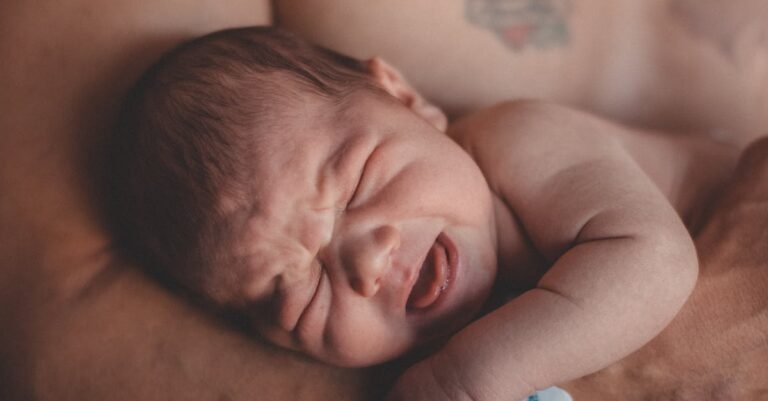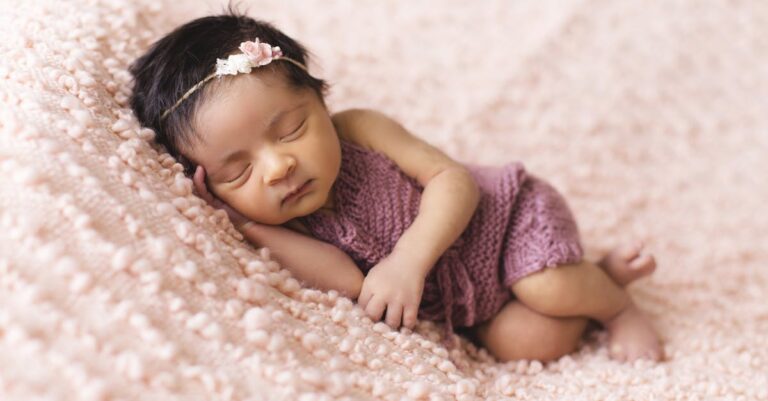When it comes to getting a good night’s sleep, parents often find themselves in a battle of wills with their little ones. Enter baby sleep positioners, the unsung heroes in the quest for peaceful slumber. These nifty gadgets promise to keep babies cozy and secure while they drift off into dreamland, leaving parents with a few extra hours of shut-eye.
Table of Contents
ToggleOverview of Baby Sleep Positioners
Baby sleep positioners aim to create a secure sleeping environment for infants. These devices come in various designs, including wedges and rails, providing support to maintain a safe sleep position. Designed primarily for infants younger than one year, positioners target preventing rolling and ensuring proper alignment.
Parents often choose sleep positioners to enhance their baby’s comfort during sleep. Studies show that infants sleeping on their backs significantly reduce the risk of Sudden Infant Death Syndrome (SIDS). Sleep positioners, when used correctly, promote this safe sleeping posture.
Featured on the market are several types of sleep positioners. Some include adjustable and custom designs, catering to different sleeping preferences. Research indicates that most comfortable sleep positioners incorporate breathable materials, promoting airflow and reducing overheating risks.
Safety standards play a crucial role in choosing a baby sleep positioner. It’s essential to select products certified by the Consumer Product Safety Commission (CPSC) and free from harmful chemicals. Some brands emphasize the use of organic materials, offering a healthier option for infants.
While sleep positioners can provide benefits, parents should always monitor their baby’s sleep. This ensures the device does not obstruct breathing or cause any discomfort. Recommendations suggest discontinuing use once the baby can roll over independently.
Promoting better sleep for both the baby and parents is the ultimate goal of using sleep positioners. With the right choice and supervision, these devices contribute to a more serene sleeping environment.
Benefits of Baby Sleep Positioners
Baby sleep positioners offer several advantages for infants, promoting better rest and safety. They assist in creating a secure environment that supports healthy sleep patterns.
Improved Sleep Quality
Improved sleep quality is one of the primary benefits of baby sleep positioners. These devices help babies remain in a comfortable position throughout the night. Babies often sleep more soundly when they feel secure and supported. Parents observe that a consistent sleep position results in longer sleep stretches. Sleep positioners can minimize startle reflexes, which often disrupt sleep. This leads to a more restful experience for both infants and their caregivers. Overall, enhanced sleep quality contributes to better development in infants as well.
Reduced Risk of Flat Head Syndrome
Reduced risk of flat head syndrome is another significant benefit associated with baby sleep positioners. The design of these positioners helps maintain proper head and neck alignment during sleep. When babies spend hours lying on their backs, they may develop flat spots on their heads. Using a sleep positioner encourages varied pressure distribution. Parents find that these devices effectively prevent the likelihood of developing positional plagiocephaly. Ensuring babies alternate their head position promotes improved skull shape and overall health. Furthermore, maintaining this alignment during sleep helps alleviate parental concerns regarding flat head syndrome.
Types of Baby Sleep Positioners
Various types of baby sleep positioners exist to enhance comfort and safety while infants sleep. Each design caters to specific needs and preferences.
Wedge Positioners
Wedge positioners provide an angled surface to support an infant’s head and upper body. This incline can help with issues such as reflux by allowing gravity to aid digestion during sleep. Many models feature soft, breathable fabrics that promote comfort. Designed for stability, these devices keep infants from rolling over once positioned correctly. The incline encourages proper positioning for airflow, reducing the risk of respiratory complications. Parents often appreciate that wedge positioners are straightforward to use and can fit in most cribs or bassinet settings.
Contoured Positioners
Contoured positioners feature curves that cradle an infant’s body, promoting alignment of the head, neck, and spine. This design reduces the likelihood of rolling, allowing for a safer sleep environment. Often made from breathable, non-toxic materials, these positioners help regulate temperature, increasing comfort. The shape encourages weight distribution to prevent flat head syndrome, ensuring a healthy skull development. Many parents prefer contoured positioners for their versatility, as they often fit both crib and portable crib setups easily. Adjustability is another key feature, allowing parents to tailor the positioning as the baby grows.
Safety Concerns
Sleep positioners may seem helpful, but they come with specific safety concerns. Parents should be aware of risks associated with their use to ensure infants sleep safely.
Risks Associated with Baby Sleep Positioners
Suffocation hazards pose a significant risk with baby sleep positioners. If infants roll or shift during sleep, they might become trapped. Some positioners can move or collapse unexpectedly, raising alarms about safety. Additionally, the Consumer Product Safety Commission (CPSC) warns against using positioners designed to restrict movement. Babies often require space to move freely as they grow, and restricting this movement could lead to serious consequences.
Recommendations from Pediatric Experts
Pediatric experts recommend that parents prioritize safe sleep practices. Positioners should meet CPSC safety standards and use breathable materials to prevent overheating. Always monitor infants while they sleep with positioners to ensure proper breathing and comfort. Experts advise discontinuing use of positioners once a baby can roll over independently. Emphasizing a flat sleep surface without additional items in the crib is crucial for reducing risks. Follow guidelines to create a secure sleeping environment and promote healthy sleep for infants.
Alternative Solutions for Sleep Support
Parents often seek alternatives to baby sleep positioners for enhancing sleep safety and comfort. Adjustable crib mattresses serve as one option. These mattresses can elevate the head slightly, benefiting babies with reflux while keeping them securely positioned.
Wearable blankets provide another solution. These sleep sacks promote warmth without loose bedding hazards, ensuring babies remain cozy and safe. Additionally, many parents find that swaddling helps newborns feel secure, mimicking the comfort of the womb and reducing startle reflex disruptions.
Furthermore, placing babies on a firm mattress with fitted sheets creates a safe sleep surface. This practice encourages proper alignment and minimizes risks associated with suffocation. Soft but breathable bedding materials contribute to airflow, helping regulate temperature.
Some parents utilize sleep monitoring devices to enhance safety. These devices track a baby’s breathing patterns and alert caregivers to any abnormalities, allowing for peace of mind. Regularly checking on infants during sleep also supports safety by preventing potential discomfort or breathing obstructions.
Creating a consistent bedtime routine significantly improves sleep quality. Many parents establish calming activities, such as reading or singing, to signal that it’s time to sleep. Maintaining a peaceful sleep environment, free from distractions and noise, further promotes restful nights.
Exploring co-sleeping arrangements, when practiced safely, offers benefits too. Room-sharing can shorten parent-baby separation and enhance bonding while keeping the baby within arm’s reach. Monitoring guidelines from pediatricians ensure that these arrangements remain safe.
Overall, these alternative solutions can effectively support healthy sleep for both infants and parents, contributing to tranquility during nighttime hours.
Conclusion
Baby sleep positioners can be a valuable tool for parents seeking to improve their baby’s sleep quality. By providing comfort and promoting safe sleeping positions, these devices support healthier sleep patterns and reduce the risk of SIDS.
Selecting the right positioner is crucial. Parents should prioritize safety standards and monitor their baby’s sleep to ensure a secure environment. While sleep positioners can enhance comfort, it’s important to remain vigilant as the baby grows and develops.
Incorporating additional sleep solutions can further contribute to a peaceful nighttime routine. With the right approach, parents can foster a serene sleep environment that benefits both their baby and themselves.



